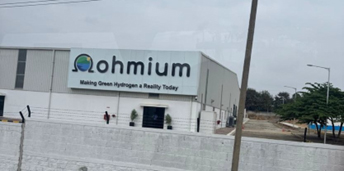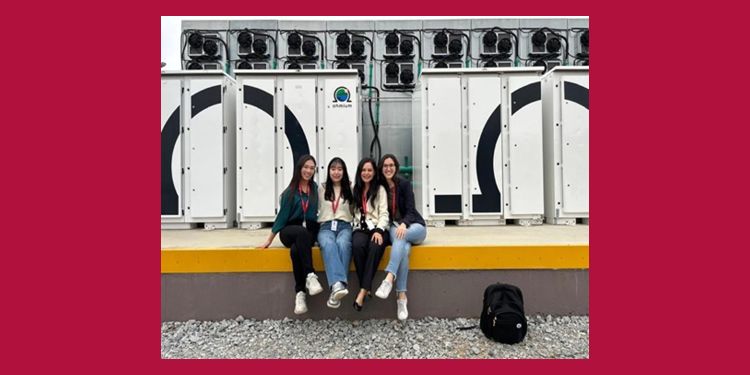Professor Vikram Gandhi’s Immersive Field Course (IFC) “Development while Decarbonizing: India’s Path to Net-Zero" delved into the critical aspect of decarbonization and sustainability goals amid India's rapid development. The course presented an opportunity for students to advance their knowledge of sustainability efforts, decarbonization, and net zero in the context of a broader development agenda. The class culminated in a series of site visits in January 2025 in Mumbai and Bangalore and this is one of 9 student essays that highlights their reflections on uncovering sustainable solutions across the country.
India, as a country which has come to embrace rapid economic growth and development, and is sometimes referred as “Rising Titan”, is seeking a way to decouple its development from emissions and to increase its energy independence. In this context, green hydrogen can play an integral role in India in achieving net zero by 2070 – in particular, green hydrogen is key to achieve carbon neutrality in hard-to abate industries such as steel, chemicals, and cement, which are growing at the same accelerated pace as the country.
Our visit to Ohmium, the first company we went to in Bangalore, provided a great introduction to the vibrant start-up scene in the city and offered a glimpse into the future of green hydrogen technology in India and beyond. Ohmium is a company focused on developing advanced PEM electrolyzers for the production of green hydrogen, and distinguishes itself through its commitment to innovation and sustainability in the energy transition. During our visit, we had the opportunity to interact with the founding and operating team, whose deep technical expertise and passion for their work were evident throughout our discussions. Below are the key takeaways and reflections we got from the site visit.

Technical Sophistication
One of the most impressive parts of the visit was seeing Ohmium's technical expertise in action. Their modular PEM electrolyzer design allows customers to adopt the technology easily, with a lead time of mere 4-7 weeks depending on location, typically in the US, India, or China. Ohmium deploys 2-10 technical experts for on-site setup and provides remote support to ensure smooth operation. Their focus on quality and attention to detail sets them apart from the cheaper alkaline alternative. Additionally, the team prioritizes vertical integration as a key differentiator, with ~80% of their components and materials being sourced from India. They are currently commercializing the 2nd generation of their products, and we were excited to learn at their site that they are now working to develop the 3rd generation, which should have higher efficiency with lower costs and land requirements. We are keen to see the technological advancements they will make next year.
Go-to-Market Strategy
The company shared that green hydrogen demand is expected to grow 30-fold by 2030. However, this market growth is only achievable if demand creation is successful. In that sense, the first hurdle they need to overcome in this nascent industry is creating the demand for their product, and to do so, they need to design a flexible product that can easily be added to the existing facilities of potential customers. We felt that their modular design was well-suited to demonstrating to customers the feasibility of operating with green hydrogen, starting with small-scale installations, and that that feature would work well to support the launch of the green hydrogen market. We also thought it made a lot of sense that they were looking to develop their business with an eye on international demand, where there is demand for “green hydrogen” and customers who are prepared to pay a premium for it.
Talent and Training
Ohmium shared that they focus on hiring young, local engineering talent with strong backgrounds in electrochemical processes—a competitive advantage given the limited availability of such specialized expertise worldwide. For technician roles, they recruit locally from community colleges and prioritize developing skills within the organization rather than hiring from competitors. At the facility, we saw clear training displays that support their well-structured programs for technicians. In the membrane room, there was a display showing dust and particles found in the product, highlighting that each particle had undergone a kaizen process to reduce contamination.
Managing Complexity of Production
We were impressed by Ohmium’s clean and well-organized facilities. We learned that Ohmium’s electrolyzers require over 3,000 components in their bill of materials, with 80% of these sourced from within India. This local sourcing approach is aligned to the government’s direction to achieve energy independence and minimizes the risk of supply chain for Ohmium. At the same time, given this intricate supply chain, it would be critical for them in the next stage of scaling up the operation to minimize production costs while maintaining high quality standards.
On the way back to the hotel, the debriefing on the bus was very lively. In order for the green hydrogen market to take off in India, there are many fundamental and structural challenges that the manufacturers of electrolyzers alone cannot control—for example, the high cost of renewable energy accounts for approximately 70% of the costs of green hydrogen, and it will take a major government initiative to develop the storage and delivery infrastructure required for the industry. There were certainly concerns raised around challenges ahead, such as the uncertainty of the market outlook and the problem of scaling up—but even so, the enthusiasm of Ohmium's leadership and employees, who are trying to launch this grand new market through innovation, excited us and left a strong impression.
After the site visit, we were honored to plant a mango tree with Professor Gandhi. We hope that in a few years, just as this tree will bear its fruit, Ohmium’s business and India will too be flourishing and leading the way in the green hydrogen industry.


